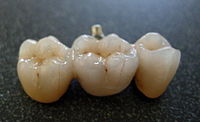
Photo from wikipedia
Debonding of zirconia cantilevered resin-bonded fixed dental prostheses (RBFDPs) remains the main treatment complication, therefore, the present in vitro study aimed to evaluate the effect of different surface pretreatments on… Click to show full abstract
Debonding of zirconia cantilevered resin-bonded fixed dental prostheses (RBFDPs) remains the main treatment complication, therefore, the present in vitro study aimed to evaluate the effect of different surface pretreatments on the bonding of zirconia RBFDPs. Eighty milled zirconia maxillary central incisors, with complementary zirconia cantilevered RBFDPs, were randomly subjected to four different surface pretreatments (n = 20): as-machined (AM); airborne-particle abraded (APA); coated with nanostructured alumina coating (NAC); incisor air-abraded and RBFDP coated (NAC_APA). After bonding, half of each group (n = 10) was stored in deionized water (150 days/37 °C), thermocycled (37,500 cycles, 5–55 °C), and cyclically loaded (50 N/1.2 × 106). Load-bearing capacity (LBC) was determined using a quasi-static test. Additionally, finite element analysis (FEA) and fractography were performed. t-test and one-way ANOVA were used for statistical-analysis. Before aging, the NAC group provided superior LBC to other groups (p < 0.05). After aging, the AM specimens debonded spontaneously, while other groups exhibited comparable LBC (p ˃ 0.05). The FEA results correlated with the in vitro experiment and fractography, showing highly stressed areas in the bonding interface, cement layer, and in RBFDP’s retainer wing and connector. The NAC RBFDPs exhibited comparable long-term bonding performance to APA and should be regarded as a zirconia pretreatment alternative to APA.
Journal Title: Materials
Year Published: 2023
Link to full text (if available)
Share on Social Media: Sign Up to like & get
recommendations!